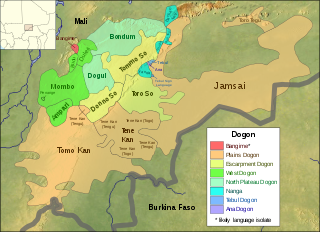Grammatical sketch
This section may need to be formatted.(April 2019) |
Susu is an SOV language, Poss-N, N-D, generally suffixing, non-pro-drop, wh-in-situ, with no agreement affixes on the verb, no noun classes, no gender, and with a clitic plural marker which attaches to the last element of the NP (N or D, typically), but does not co-occur with numerals. It has no definite or indefinite articles. Sentential negation is expressed with a particle, mu, whose distribution is unclear (with adjectival predicates it seems to sometimes infix, but with transitive verbs it comes before the object).
Examples:
khame
man
didi
boy
to
see
ne
PAST
"The/a man saw the/a boy."
Pronouns
n
1sg
taami
bread
don
eat
ma
PRES(generic)
"I eat bread."
i
2sg
taami
bread
don
eat
ma
PRES(generic)
"You (sg) eat bread."
a
3sg
taami
bread
don
eat
ma
PRES(generic)
"He/she/it eats bread."
won
1inc.pl
taami
bread
don
eat
ma
PRES(generic)
"We (including you) eat bread."
mukhu
1exc.pl
taami
bread
don
eat
ma
PRES(generic)
"We (excluding you) eat bread."
wo
2pl
taami
bread
don
eat
ma
PRES(generic)
"You (pl or polite [sg or pl]) eat bread." ("wo" is used as French "vous")
e
3pl
taami
bread
don
eat
ma
PRES(generic)
"They eat bread."
cf.
n
1sg
bankhi
house
to
see
né
PAST
"I saw a/the house."
n
1sg
taami
bread
don
eat
fe
PROG
"I am eating the bread."
Object pronouns have the same form as subject pronouns:
khame
man
n
1sg
to
see
né
PAST
"A/the man saw me."
khame
man
i
2sg
to
see
né
PAST
"A/the man saw you (sg)."
khame
man
a
3sg
to
see
né
PAST
"A/the man saw him/her/it."
khame
man
won
1inc.pl
to
see
né
PAST
"A/the man saw us (including you)."
khame
man
mukhu
1exc.pl
to
see
né
PAST
"A/the man saw us (excluding you)."
khame
man
wo
2pl
to
see
né
PAST
"A/the man saw you (pl)."
khame
man
e
3pl
to
see
né
PAST
"A/the man saw them."
Possessive affixes precede the noun:
baba "father": m baba "my father" i baba "your (sg) father" a baba "his/her/its father" wom baba "our father" wo baba "your (pl) father" e baba "their father"
Adverbs
Adverbs can precede the subject or follow the verb:
khoro
yesterday
n
1sg
fa
arrive
né
PAST
"Yesterday I arrived."
n
1sg
fa
arrive
né
PAST
khoro
yesterday
"I arrived yesterday."
Grammatical number
NPs come in a variety of forms:
khamé "boy (sg)", khame e "boys (pl) taami "bread (sg)", taami e "breads (pl)"
khame
boy
e
pl
taami
bread
don
eat
ma
PRES
"The/0 boys eat bread."
khamé
boy
taami
bread
e
pl
don
eat
ma
PRES
"The/a boy eats breads."
Numerals
- woto keren car one "one car"
- woto firin car two "two cars"
- woto sakhan "three cars"
- woto nani "four cars"
- woto suli "five cars"
- woto senni "six cars"
- woto solofere "seven cars"
- woto solomasakhan "eight cars"
- woto solomanani "nine cars"
- woto fu "ten cars"
- woto fu nun keren "eleven cars"
- woto fu nun firin "twelve cars"
n woto nde e to né 1sg car indef.D pl see PAST "I saw several cars"/"J'ai vu des autos." woto nde "some car" di nde "some boy" bangkhi nde "some house" khame nde "someone" se nde "something" nde "who/some" i nde to? you who see "Who did you see?" i munse don ma? 2sg what eat PRES "What will you eat?"




